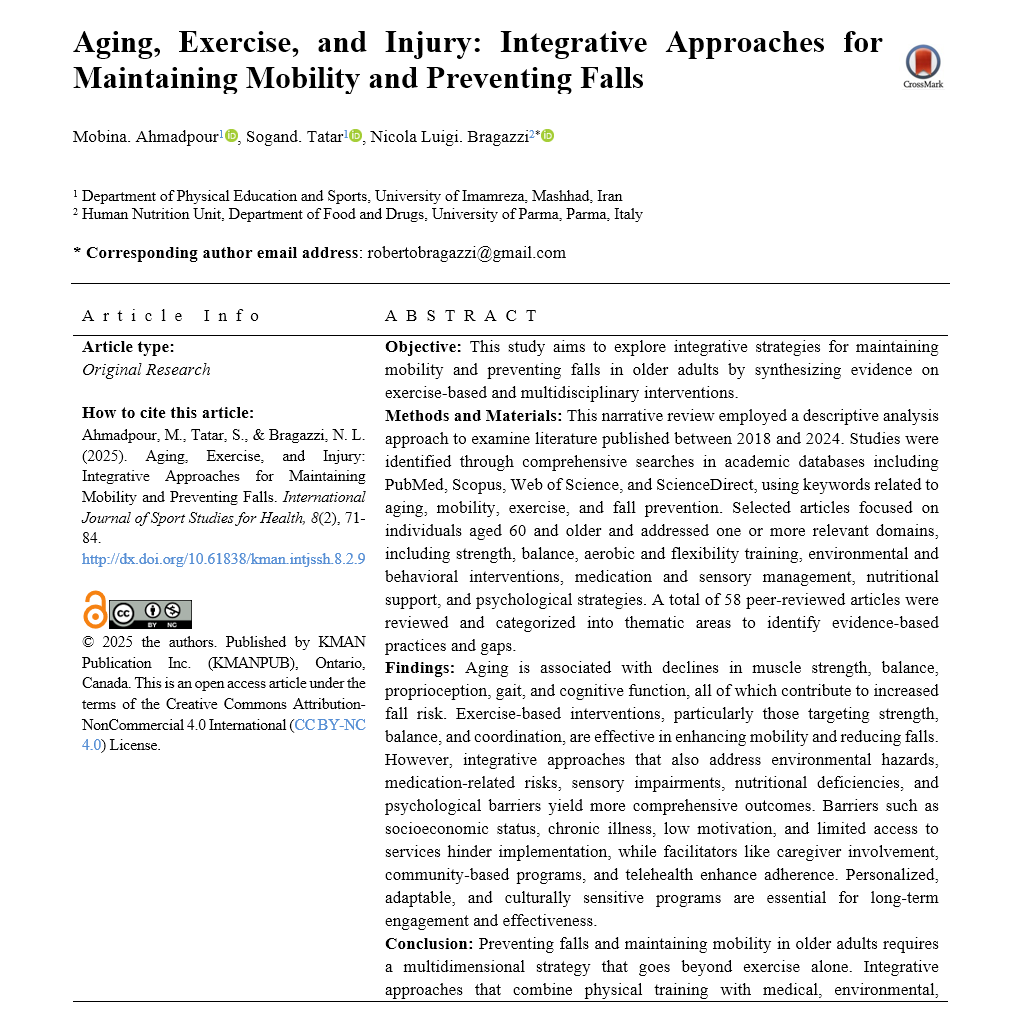Aging, Exercise, and Injury: Integrative Approaches for Maintaining Mobility and Preventing Falls
Keywords:
Aging, fall prevention, mobility, exercise interventions, integrative strategies, older adults, adherence barriers, multidisciplinary approachesAbstract
Objective: This study aims to explore integrative strategies for maintaining mobility and preventing falls in older adults by synthesizing evidence on exercise-based and multidisciplinary interventions.
Methods and Materials: This narrative review employed a descriptive analysis approach to examine literature published between 2018 and 2024. Studies were identified through comprehensive searches in academic databases including PubMed, Scopus, Web of Science, and ScienceDirect, using keywords related to aging, mobility, exercise, and fall prevention. Selected articles focused on individuals aged 60 and older and addressed one or more relevant domains, including strength, balance, aerobic and flexibility training, environmental and behavioral interventions, medication and sensory management, nutritional support, and psychological strategies. A total of 58 peer-reviewed articles were reviewed and categorized into thematic areas to identify evidence-based practices and gaps.
Findings: Aging is associated with declines in muscle strength, balance, proprioception, gait, and cognitive function, all of which contribute to increased fall risk. Exercise-based interventions, particularly those targeting strength, balance, and coordination, are effective in enhancing mobility and reducing falls. However, integrative approaches that also address environmental hazards, medication-related risks, sensory impairments, nutritional deficiencies, and psychological barriers yield more comprehensive outcomes. Barriers such as socioeconomic status, chronic illness, low motivation, and limited access to services hinder implementation, while facilitators like caregiver involvement, community-based programs, and telehealth enhance adherence. Personalized, adaptable, and culturally sensitive programs are essential for long-term engagement and effectiveness.
Conclusion: Preventing falls and maintaining mobility in older adults requires a multidimensional strategy that goes beyond exercise alone. Integrative approaches that combine physical training with medical, environmental, nutritional, and psychological components are more effective in addressing the complex nature of fall risk. Future research should focus on tailoring interventions to diverse populations, leveraging technology, and embedding fall prevention into routine healthcare and community settings.
Downloads
References
1. Polavarapu C. Evidence-Based Strategies for Injury Prevention and Exercise Prescription in Elderly Communities: The Physical Therapist's Perspective. International Journal of Science and Healthcare Research. 2024;6(4):371-80. [DOI]
2. Elmaghfuroh DR, Haryanti DY, Romadhoni RR. Implementation of Maintaining Mobility to Reduce the Risk Falls in Elderly. Professional Health Journal. 2024;6(1):168-76. [DOI]
3. Pardini RM. Development and Evaluation of Virtual Assistant to Assist Elderly Caregivers. 2024. [DOI]
4. Landsberger BH. Long-Term Care for the Elderly. 2024. [DOI]
5. Chen X, Qu X. Age-Related Differences in the Relationships Between Lower-Limb Joint Proprioception and Postural Balance. Human Factors the Journal of the Human Factors and Ergonomics Society. 2018;61(5):702-11. [PMID: 30130130] [DOI]
6. Alves JE, Lucas Nogueira de Carvalho P, Porcatti LR, Ansai JH, Maria Juana Beatriz Lima C, Say KG. Effects of a Cognitive Stimulation Program on Physical and Cognitive Dimensions in Community-Dwelling Faller Older Adults With Cognitive Impairment: Study Protocol. BMC Neurology. 2023;23(1). [PMID: 36932354] [PMCID: PMC10020753] [DOI]
7. Racey M, Markle‐Reid M, Fitzpatrick‐Lewis D, Ali MU, Gagné H, Hunter S, et al. Fall Prevention in Community-Dwelling Adults With Mild to Moderate Cognitive Impairment: A Systematic Review and Meta-Analysis. BMC Geriatrics. 2021;21(1). [PMID: 34893027] [PMCID: PMC8665555] [DOI]
8. Dawson R, Suen J, Sherrington C, Kwok W, Pinheiro MB, Haynes A, et al. Effective Fall Prevention Exercise in Residential Aged Care: An Intervention Component Analysis From an Updated Systematic Review. British Journal of Sports Medicine. 2024;58(12):641-8. [PMID: 38658135] [PMCID: PMC11187368] [DOI]
9. Sadaqa M, Németh Z, Makai A, Prémusz V, Hock M. Effectiveness of Exercise Interventions on Fall Prevention in Ambulatory Community-Dwelling Older Adults: A Systematic Review With Narrative Synthesis. Frontiers in Public Health. 2023;11. [PMID: 37601180] [PMCID: PMC10435089] [DOI]
10. Henry A, Haddad YK, Bergen G. Older Adult and Healthcare Provider Beliefs About Fall Prevention Strategies. American Journal of Lifestyle Medicine. 2022;18(1):108-17. [PMID: 39184271] [PMCID: PMC11339757] [DOI]
11. Lee K, Yi J, Lee SH. Effects of Community-Based Fall Prevention Interventions for Older Adults Using Information and Communication Technology: A Systematic Review and Meta-Analysis. Health Informatics Journal. 2024;30(2). [PMID: 38825745] [DOI]
12. Månsson L, Lundin‐Olsson L, Skelton DA, Janols R, Lindgren H, Rosendahl E, et al. Older Adults' Preferences For, Adherence to and Experiences of Two Self-Management Falls Prevention Home Exercise Programmes: A Comparison Between a Digital Programme and a Paper Booklet. 2020. [DOI]
13. Sung P, Lee M-LJ, Tan KY, Malhotra R, Chan A. Transitions in Adherence Trajectories From Intervention to Maintenance of a Falls Prevention Exercise Program. Innovation in Aging. 2021;5(Supplement_1):447-. [PMCID: PMC8970022] [DOI]
14. Shin S-h, Wüensche B. What Type of Exercises Should Older Adults Engage in to Improve Fall Efficacy and Physical Fitness Related to Falling? Journal of Exercise Rehabilitation. 2023;19(4):198-207. [PMID: 37662531] [PMCID: PMC10468295] [DOI]
15. Tiedemann A, O'Rourke SD, Sherrington C. Is a Yoga-Based Program With Potential to Decrease Falls Perceived to Be Acceptable to Community-Dwelling People Older Than 60? Public Health Research & Practice. 2018;28(2). [PMID: 29925087] [DOI]
16. Zhou Y, Ishado E, Sadak T. Challenge or Opportunity? Impacts of Falls Among Older Adults Living With Dementia on Their Care Partners. Innovation in Aging. 2021;5(Supplement_1):930-1. [PMID: PMC8682015] [DOI]
17. Finnegan S, Bruce J, Seers K. Life After Falls Prevention Exercise – Experiences of Older People Taking Part in a Clinical Trial: A Phenomenological Study. BMC Geriatrics. 2021;21(1). [PMID: 33517904] [PMCID: PMC7849142] [DOI]
18. Arnold CM, Lanovaz JL, Farthing JP, Legg HS, Weimer M, Kim S. Fall Arrest Strategy Training Improves Upper Body Response Time Compared to Standard Fall Prevention Exercise in Older Women: A Randomized Trial. Clinical Rehabilitation. 2022;36(7):940-51. [PMID: 35287479] [PMCID: PMC9189718] [DOI]
19. Feng F, Xu H, Sun Y, Zhang X, Li N, Sun X, et al. Exercise for Prevention of Falls and Fall-Related Injuries in Neurodegenerative Diseases and Aging-Related Risk Conditions: A Meta-Analysis. Frontiers in Endocrinology. 2023;14. [PMID: 37534209] [PMCID: PMC10393124] [DOI]
20. Sandlund M, Pohl P, Ahlgren C, Skelton DA, Melander‐Wikman A, Bergvall‐Kåreborn B, et al. Gender Perspective on Older People’s Exercise Preferences and Motivators in the Context of Falls Prevention: A Qualitative Study. Biomed Research International. 2018;2018:1-11. [PMID: 30112416] [PMCID: PMC6077582] [DOI]
21. Li F, Harmer P, Fitzgerald K, Eckstrom E, Akers L, Chou LS, et al. Effectiveness of a Therapeutic Tai Ji Quan Intervention vs a Multimodal Exercise Intervention to Prevent Falls Among Older Adults at High Risk of Falling. Jama Internal Medicine. 2018;178(10):1301. [PMID: 30208396] [PMCID: PMC6233748] [DOI]
22. Månsson L, Lundin‐Olsson L, Skelton DA, Janols R, Lindgren H, Rosendahl E, et al. Older Adults Preferences For, Adherence to and Experiences of Two Self-Management Falls Prevention Home Exercise Programmes: A Comparison Between a Digital Programme and a Paper Booklet. 2019. [DOI]
23. Pettersson B, Wiklund M, Janols R, Lindgren H, Lundin‐Olsson L, Skelton DA, et al. ‘Managing Pieces of a Personal Puzzle’ — Older People’s Experiences of Self-Management Falls Prevention Exercise Guided by a Digital Program or a Booklet. BMC Geriatrics. 2019;19(1). [PMID: 30777026] [PMCID: PMC6378707] [DOI]
24. Limaye SB, Patil H. The Effect of Otago Exercise Program for Fall Prevention in Alcoholic Neuropathy Patients. International Journal of Health Sciences and Research. 2022;12(6):168-73. [DOI]
25. Willemse L, Wouters E, Pisters MF, Vanwanseele B. Effects of a 12-Week Intrinsic Foot Muscle Strengthening Training (STIFF) on Gait in Older Adults: A Parallel Randomized Controlled Trial Protocol. BMC Sports Science Medicine and Rehabilitation. 2024;16(1). [PMID: 39033125] [PMCID: PMC11542310] [DOI]
26. Pita MN, Sari CP, Muliono AC. Literature Study: The Difference in Risk of Falls Before and After Chair-Based Exercise on Elderly. Journal of Widya Medika Junior. 2021;3(4):225-9. [DOI]
27. Mogle J, Linden‐Carmichael AN, Miller S, Almeida DM. Daily Alcohol Use Covaries With Daily Concentration Problems Across the Lifespan: Findings From the MIDUS Refresher. Innovation in Aging. 2021;5(Supplement_1):692-. [DOI]

Downloads
Additional Files
Published
Issue
Section
License
Copyright (c) 2025 Mobina Ahmadpour, Sogand Tatar (Author); Nicola Luigi Bragazzi (Corresponding Author)

This work is licensed under a Creative Commons Attribution-NonCommercial 4.0 International License.







